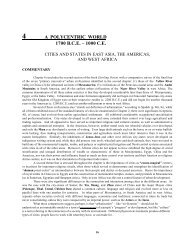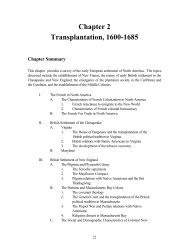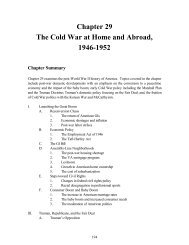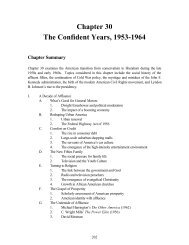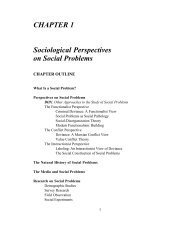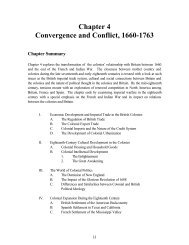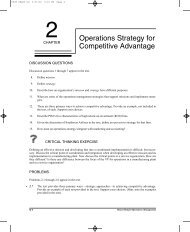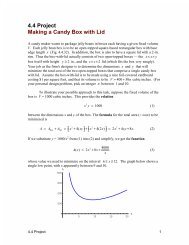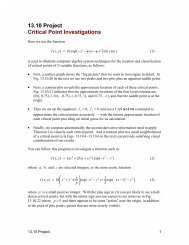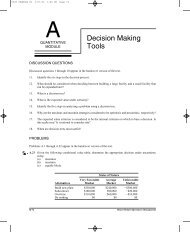Merchandising Operations and the Accounting Cycle - Pearson
Merchandising Operations and the Accounting Cycle - Pearson
Merchandising Operations and the Accounting Cycle - Pearson
You also want an ePaper? Increase the reach of your titles
YUMPU automatically turns print PDFs into web optimized ePapers that Google loves.
LEARNING TIP<br />
The adjusting <strong>and</strong> closing entries<br />
here are very similar to those<br />
discussed in Chapter 4, pages<br />
172–179. The closing entries also<br />
clear <strong>the</strong> Cost of Goods Sold<br />
expense account for accumulating<br />
costs in <strong>the</strong> next period.<br />
242 Part One The Basic Structure of <strong>Accounting</strong><br />
• Selling expenses are those expenses related to marketing <strong>the</strong> company’s products—sales<br />
salaries; sales commissions; advertising; amortization, rent, utilities,<br />
<strong>and</strong> property taxes on store buildings; amortization on store furniture;<br />
delivery expense; <strong>and</strong> so on.<br />
• General expenses include office expenses, such as <strong>the</strong> salaries of <strong>the</strong> company<br />
president <strong>and</strong> office employees; amortization, rent, utilities, property taxes<br />
on <strong>the</strong> home office building; <strong>and</strong> office supplies.<br />
The Forzani Group Ltd. (Exhibit 5-1) separates store operating (selling) <strong>and</strong> general<br />
<strong>and</strong> administrative expenses for reporting on <strong>the</strong> income statement.<br />
Gross margin minus operating expenses equals income from operations, or<br />
operating income. Many people view operating income as an important indicator<br />
of a business’s performance because it measures <strong>the</strong> results of <strong>the</strong> entity’s major<br />
ongoing activities.<br />
The last section of Austin Sound’s income statement is o<strong>the</strong>r revenue <strong>and</strong> expense.<br />
This category reports revenues <strong>and</strong> expenses that are outside <strong>the</strong> main operations of<br />
<strong>the</strong> business. Examples include gains <strong>and</strong> losses on <strong>the</strong> sale of capital assets (not<br />
inventory) <strong>and</strong> gains <strong>and</strong> losses on lawsuits. Accountants have traditionally viewed<br />
Interest Revenue <strong>and</strong> Interest Expense as “o<strong>the</strong>r” items, because <strong>the</strong>y arise from<br />
loaning money <strong>and</strong> borrowing money. These are financing activities that are outside<br />
<strong>the</strong> operating scope of selling merch<strong>and</strong>ise. The Forzani Group Ltd.’s income statement<br />
in Exhibit 5-1 shows interest expense <strong>and</strong> amortization expense as separate expenses.<br />
The bottom line of <strong>the</strong> income statement is net income:<br />
Net income = Total revenues <strong>and</strong> gains – Total expenses <strong>and</strong> losses<br />
We often hear <strong>the</strong> term bottom line used to refer to a final result. Bottom line originated<br />
in <strong>the</strong> position of net income on <strong>the</strong> income statement.<br />
Statement of Retained Earnings A merch<strong>and</strong>iser’s statement of retained earnings<br />
looks exactly like that of a service business. In fact, you cannot determine<br />
whe<strong>the</strong>r <strong>the</strong> entity sells merch<strong>and</strong>ise or services from looking at <strong>the</strong> statement of retained<br />
earnings.<br />
Balance Sheet If <strong>the</strong> business is a merch<strong>and</strong>iser, <strong>the</strong> balance sheet shows inventory<br />
as a major current asset. In contrast, service businesses usually have no inventory<br />
at all or minor amounts of inventory.<br />
Journalizing <strong>the</strong> Adjusting <strong>and</strong> Closing Entries for a<br />
<strong>Merch<strong>and</strong>ising</strong> Business<br />
Exhibit 5-8 presents Austin Sound Centre Inc.’s adjusting entries, which are similar<br />
to those you have seen previously, except for <strong>the</strong> inventory adjustment [entry (b)].<br />
The closing entries in <strong>the</strong> exhibit also follow <strong>the</strong> pattern illustrated in Chapter 4.<br />
The first closing entry debits <strong>the</strong> revenue accounts for <strong>the</strong>ir ending balances. The<br />
offsetting credit of $170,300 transfers <strong>the</strong>ir sum to Income Summary. This amount<br />
comes directly from <strong>the</strong> credit column of <strong>the</strong> income statement on <strong>the</strong> work sheet<br />
(Exhibit 5-6).<br />
The second closing entry includes credits to Cost of Goods Sold, to <strong>the</strong> contra revenue<br />
accounts (Sales Discounts, Sales Returns <strong>and</strong> Allowances), <strong>and</strong> to <strong>the</strong> expense<br />
accounts. The offsetting $116,450 debit to Income Summary represents <strong>the</strong> amount<br />
of total expenses plus <strong>the</strong> contra revenue accounts, which come from <strong>the</strong> debit column<br />
of <strong>the</strong> income statement on <strong>the</strong> work sheet.<br />
The last two closing entries close net income from Income Summary <strong>and</strong> also close<br />
dividends into <strong>the</strong> Retained Earnings account.<br />
Study Exhibits 5-6, 5-7, <strong>and</strong> 5-8 carefully because <strong>the</strong>y illustrate <strong>the</strong> entire<br />
end-of-period process that leads to <strong>the</strong> financial statements. As you progress<br />
through this book, you may want to refer to <strong>the</strong>se exhibits to refresh your underst<strong>and</strong>ing<br />
of <strong>the</strong> adjusting <strong>and</strong> closing process for a merch<strong>and</strong>ising business.



